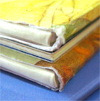|
|
|
|
|
|
|

| 최근 이 책을 구매하신 다른 회원의 책장 |
|
 |
|
|
|
[ 책 소개 ]
* A School Library Journal Best Book
* An ALA Notable Book
The Storm Book, Mr. Rabbit and the Lovely Present 등으로 Caldecott상을 받은 작품들의 글을 쓴 Charlotte Zolotow의 대표작중 하나입니다.
서쪽 하늘에 아름다운 노을을 남기고 사라지는 해를 보며 소년은 즐거운 하루가 끝나는 것을 아쉬워 합니다. 잠자리에서 엄마는 소년에게 끊임없는 자연의 순환에 대해서 설명해 줍니다. "해가 지면 밤이 시작되고 그리고 어디에선가는 새로운 해가 떠오른단다. 바람이 불고 지나가면 그 바람은 다른 곳으로 가서 다른 나뭇잎을 흔들지. 민들레 꽃씨가 날라가면 다른 곳에 뿌리를 내리고 새로운 민들레 꽃을 피운단다..." 엄마의 자연의 법칙에 대한 설명은 산, 파도, 비, 구름, 낙엽, 게절로 계속 이어집니다. 엄마의 설명을 들은 소년은 아름다운 자연의 꿈을 꾸면서 행복한 잠에 빠져듭니다.
오랫동안 보관하실 수 있는 | 닫기x |  What is 하드커버? What is 하드커버?
양장본이라고도 불리우며, 표지가 단단한 판지로 만들어진 책입니다.
판지를 천이나 가죽으로 감싸기도 합니다. 책의 속지는 일반적으로 중성처리된 종이(Acid-free paper)를 사용해서 잘 변질이 되지 않기 때문에 오랫동안 보관하기에 적합합니다. 이 종류의 책은 더스트 재킷, 또는 더스트 커버로 불리는 표지덮개가 함께 있는 경우가 많습니다. 간혹 내부 속지가 콩기름 코팅이 된 경우 고약한 냄새가 나는 책도 있습니다.
|
[ 서지 정보 ]
Hardcover, 32 pages
ISBN-10: 0060254254
ISBN-13: 978-0060254254
책 크기: 26 cm x 23 cm
[ 영문 서평 ]
Book Description
Where does the wind go when it stops?
When a little boy asks this question at the end of a happy day, his mother explains that the wind does not stop-it blows away to make the trees dance somewhere else.
Reassuringly, she tells him that nothing ever ends, it simply begins in another place or in another way. Rain goes back into the clouds to create new storms, waves fold back upon the sea to become new waves, and the day moves on to make way for the night, bringing the darkness and stars for the little boy to dream in.
Charlotte Zolotow's lyrical prose and Stefano Vitale's rich illustrations make this a beautiful celebration of the cycle of life.
Synopsis
A mother explains to her son that in nature an end is also a beginning as day gives way to night, winter ends and spring begins, and, after it stops falling, rain makes clouds for other storms.
Booklist
At the close of a wonderful day, a young boy asks his mother why the day must end. "Nothing ends," he is told. "It begins in another place or in a different way." In this revised and newly illustrated edition of Zolotow's 1962 picture book, the boy's gently probing questions are answered and nature's never-ending cycle of renewal is revealed. Without compromising the ethereal quality of the original book, extraneous text has been eliminated and some of the words and sentences have been rearranged to give the story a smoother flow. Exquisite paintings by Italian illustrator Vitale replace the black-and-white drawings of the first edition. The full-color scenes, painted on wood, gloriously depict heaven and earth and give concrete meaning to abstract concepts. Not only wonderful for lap sharing, this beautiful book will also be a rich supplement for a science unit on the elements or the seasons.
Children's Literature
When the Wind Stops is a classic children's book, written over 30 years ago, that has been reissued with new illustrations. Gentle, full page pictures, bathed in earth tones, introduce us to the circle of life. The books begins with a child's simple question-Why does the day have to end? In the answer "Nothing ends" lies the reason for the book. In simple, sweet language, the boy's mother explains that the day doesn't end at all, it merely begins somewhere else. The night doesn't end either, it, too, begins in another place. In fact, nothing ends, things only begin in other places or in other ways. Mother and son then discuss more-the wind, the dandelion fluff, the mountains, the waves, the rain, the clouds, the leaves, the seasons. Satisfied with the answers, the boy settles in to sleep, knowing that when he wakes, the moon will be beginning a night far away and the sun will be here to begin a new day.
School Library Journal
A perfect introduction to natural science. Although this new version (Harper, 1962; o.p.) has a completely new look and the text has been revised somewhat, the quiet, contemplative mood is unchanged. A young boy is reluctant for his day to end, but his mother assures him that nothing in the natural world ends. ``It begins in another place, or in a different way.'' She responds with rich verbal images to his questions about where the wind, waves, and clouds go, and about the changes of the seasons. Revisions in the text include more questions about the environment and the elimination of questions about man-made things, such as trains and roads. Vitale's illustrations provide a visual response to the simple questions asked, while adding interesting detail about various forms of underwater life, the elements of storms, and landscapes in other parts of the world. Using paint on wood, the artist includes several different styles of modern art. There are hints of Van Gogh, Chagall, and others. Some scenes are done in the folk-art style the illustrator used so successfully in Jim Aylesworth's The Folks in the Valley (HarperCollins, 1992). Together art and text make this new edition a hymn to the continuity of the natural world. |
|
|
|
|
 |
제품상제정보 배송/반품/교환 안내 |
|
|
|
Super Buy 도서는 미국 출판사의 재고도서(Remainder Book), 초과출간도서(Excess Inventory), 할인도서(Bargain Books)
등을 직수입해서 정가의 55%~80%를 할인한 가격에 판매하는 제품입니다.
Super Buy 책의 품질은 거의 새 책과 같은
수준이지만, 간혹 커버의 스크래치나 접힘과 같은 하자나, 책 하단의 재고도서 마크가 있을 수 있습니다.
저렴하게 판매하는 Super Buy 제품의 특성상 반품이 되지 않습니다만, 파본인 경우에는 착불로 반품하시면 책값을
환불해드리거나 적립금으로 올려드립니다. (반품 전에 연락 요망)
하프프라이스북에서는 중고도서(second hand book)를 취급하지 않습니다.
|
|
|
 - 등록된 128,123건의 서평이 있습니다. - 등록된 128,123건의 서평이 있습니다.
| 더보기 
|
|
|
|
|
|
|
 |
|
|
|
|
|
|